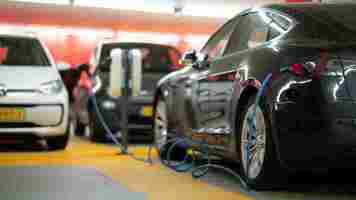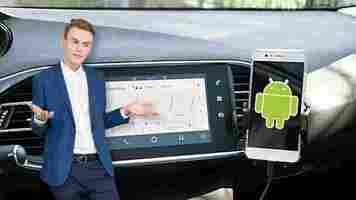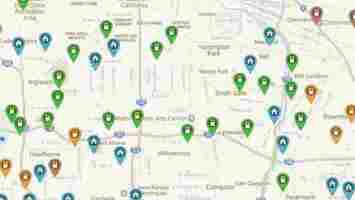How skeuomorphism is holding back the future of EV charging
This article was written by Juan Btesh on The Urban Mobility Daily , the content site of the Urban Mobility Company, a Paris-based company which is moving the business of mobility forward through physical and virtual events and services. Join their community of 10K+ global mobility professionals by signing up for the Urban Mobility Weekly newsletter . Read the original article here and follow them on Linkedin and Twitter .

Those of us who are not language experts will need a definition for the decorous new word in the title:
A skeuomorphism is a design principle in which an object is made to resemble an older version of itself, by retaining attributes that were inherent to the original.
Skeuomorphism gained popularity in the past few decades and became especially accepted in UI design. Former SVP of iOS and Steve Jobs protégé , Scott Forstall, was responsible for the well-known skeuomorphic design in early Apple products, from the Newsstand to the sound of the shutter button in the camera. Apps such as the calculator, the calendar, the stopwatch, or the notepad mimicked their real-world counterparts to make interfaces more intuitive while users entered the unfamiliar digital terrain.
Ske u omorphism can be deliberately employed as a guiding hand for new design to be better accepted. It can be seen as a tool for helping the paradigm shift between two different versions of the same thing. But it can also be an accidental consequence of cultural influences and creativity obstructions from the designer.
*But unintended skeuomorphism will restrain the new design to functions that are no longer needed, and can mitigate the advantages of the new technology that made design evolve in the first place.
In the late XIX century, the idea of a horseless carriage was the best way to explain the transition from horse-powered carriages to combustion engine vehicles. People could not imagine a 4-wheeled vehicle being moved around by something else than a horse. These “horseless carriages” were the first cars designed, and were notably similar to existing horse-drawn carriages but with a motor attached under the floorboards.
Uriah Smith was one of the many having a hard time accepting such a radical and implausible concept as a horseless carriage. He had to come up with an idea of a car with a wooden horse head and neck attached to the front. By making the car resemble a horse and a carriage, he was looking to trick (real) horses and avoid them being frightened by the new machines driving around. The name of it was Horsey Horseless and made it to Time Magazine’s 50 worst cars of all time .
The effort put in designing such an object in the wrong direction, inevitably makes us question if we are making the same mistake nowadays. Are we being skeuomorphic in the current mobility scenario to avoid any “horses” to be frightened? What is today’s Horsey Horseless ?
Fortunately, electric vehicles (EVs) are becoming more and more widespread . They operate just like a petrol car, except they run on energy taken from a battery. When the battery dies, the charging process is analog to the old technology: you need to plug your EV in to some form of electric power station and wait for it to be charged and available to drive again. Right? Well, not quite. This scheme is taking the old petrol-based charging pattern to the new electric vehicle landscape and holding us back to what we really need. We are being skeuomorphic.
EV chargers don’t need to be a metaphor of ancient petrol pumps, and need to be thoroughly thought through.
While these skeuomorphic EV chargers were initially necessary as a transition for user acceptance and adoption, we are standing at a point in which new technologies can be incorporated. Just as if we were to design a mobile app for children who did not grow up with analogue devices, skeuomorphism is not necessary anymore.
To begin with, electricity is ubiquitous — fuel is not. We don’t always need to drive to what we know as ‘gas stations’, when we have electric sockets in our own houses. Wallbox , a Spanish EV charging company manufactures and distributes devices for domestic charging . You park your EV at home, plug it in and voilá , it charges while you sleep. The charge-at-home concept is a couple of years old now and breaks the skeuomorphic design we discussed. But what if we didn’t even want to plug in our vehicles?
Induction charging allows you to charge your vehicle anywhere you park , or even while riding on specific roads without any need for cables. Qualcomm is one of the players leading the inductive charging industry. This is definitely innovative, but it looks expensive, unrealistic and circumscribed to limited areas for the time being.
Charging your vehicle is a hassle. Nobody wants to do it and we all wish for a vehicle that could drive indefinitely. Batteries need to be recharged, and fuel tanks have to be filled every time they empty, which takes time and occupies attention.
A successful charging scheme will meet the customer job needed to be done: unlimited driving range and maximum vehicle uptime.
While traditionally it was inconceivable to go to a gas station and swap your 60L fuel tank for a full one in a couple of seconds, this is no longer science fiction if we have vehicles supplied with electric batteries. Battery swapping was unsuccessfully introduced to electric cars , but is now a hot topic in light electric vehicles (LEVs). Swobbee , a Berlin-based start-up is one of the promising players in the battery-swap industry. By deploying a network of 24/7 available battery stations for a variety of vehicles (e-scooters, e-bikes, mopeds) they allow battery-swapping in under a minute and make you forget about the annoying process of recharging.
Battery-swapping gives a virtually unlimited vehicle range: just change the battery and carry on. This minimizes downtime and ensures your vehicle is always available.
While skeuomorphism in EV charging is erased by the battery swapping scheme, we can still go the extra mile if we make an holistic approach to the urban mobility scenario integrated with the electric network in cities.
Gogoro , the largest battery swapping network in the world, actually regard themselves as an energy company. Sun mobility in India claim to be “rethinking energy to transform urban mobility”.
The mobility transition is also an energy transition. Innovative solutions in the transport/mobility sector need to interact with energy solutions and consolidate smart grids.
Swobbee intends to build a dense swapping network. Decentralized storage capacities allow additional services such as peak shaving, in which stations can intelligently make real-time cost-efficient decisions to recharge batteries during off-peak pricing. This means you can charge your batteries whenever electricity rates are at their lowest, saving money and minimizing environmental footprint.
There’s an elephant in the room that needs to be addressed by emerging Battery-as-a-Service companies: battery disposal . Depending on each business model, the battery owner can be one of the following: the user, the battery-swap company, the vehicle manufacturer, or a third party. What is certain is that there needs to be someone accountable for the battery’s entire lifecycle, and this will typically be the player that brings the company to the market.
Battery-swap schemes introduce a larger number of batteries to the market, which need a sustainable approach to disposal and recycling.
From high wheelers early cars to grilles in electric vehicles, and even in the EV charging signs we see on roads, skeuomorphism has been present all along in transport. Battery-swap is the least skeuomorphic alternative available, and has the potential to bridge the gap between the mobility and energy sectors. For a successful scheme, battery-swapping needs to:
Be powered from renewable energy sources.
Have a dense and extensive network of mobility hubs with stations spread all over the operations area to guarantee availability.
Allow for different types of batteries from different types of vehicles and brands.
Be accountable for battery disposal and consider a battery recycling scheme.
Contemplate safe handling of batteries, with intuitive and inclusive design so anyone can successfully swap batteries.
Skeuomorphism can really hold us back against innovation and technological progress. By scrubbing away old petrol-based influences and thinking of mobility integrated within the urban environment, we will get to the charging scheme we really need.
Do EVs excite your electrons? Do ebikes get your wheels spinning? Do self-driving cars get you all charged up?
Then you need the weekly SHIFT newsletter in your life. Click here to sign up .
Android Auto is reading notifications in the wrong language — and Google’s solution is terrible
Over the past 18 months, some Android Auto users have reported that Android Auto is getting its languages confused and reading notifications in a garbled mess of words that make no sense.

Based on what users are reporting, it seems that Google Assistant in the car-based app is attempting to read incoming messages in a secondary language, but is interpreting those messages based on its primary language.
One French user , whose phone is set to French, says that Android Auto is trying to read notifications in English, even though the messages are written in French. The result is a mess of mispronounced words that make no sense, they say.
Another user reports the same is happening to them, except their phone is set to English, and it’s trying to read messages in Russian.
The Google support forum thread where Android Auto users came to discuss had over 900 comments and 1,400 up votes. It’s not exactly a fringe collection of cases.
In short, it makes the voice read notifications totally unusable, and has been plaguing users since 2019. Thankfully, Google finally has a solution!
Buuuut, it leaves a lot to be desired.
As Android Police reports , Google‘s recommendation, which has taken them more than a year to come up with, is to just delete the secondary language from your phone.
It’s not exactly a solution if you require that language for other apps or functions on your phone. But even so, Google still had the audacity to mark this problem as “addressed” in its list of known issues .


The Big G also lists this solution on its official Google Assistant help page .
Another huge problem with this solution is that deleting secondary languages from your phone, means you can no longer address Google Assistant in that language. As many bilingual people will know, there are some words and phrases that just don’t translate, and need to be spoken in a second language.
Considering that nearly half of the world speaks more than one language , Google really needs to pull its finger out and fix this properly. Bilingual users shouldn’t have to sacrifice secondary languages just so that Android Auto reads notification properly.
SHIFT is brought to you by Polestar. It’s time to accelerate the shift to sustainable mobility. That is why Polestar combines electric driving with cutting-edge design and thrilling performance. Find out how .
5 apps every electric vehicle owner needs to know about
Switching to an electric vehicle might mean that you find yourself relying on your smartphone a bit more than usual in order to find places to fuel up. No longer can you go to the petrol station around the corner or just off your exit on the highway. At first, you’ll have to be slightly more strategic about refueling, but with the help of apps that direct you to EV charging stations near you, you’ll find that adjusting is easy.

Most popular app for finding charging stations: PlugShare
PlugShare is one of the most well-known apps for finding EV charging stations around the world because it’s incredibly comprehensive. You can filter the map by plug type, including Level 1, Level 2, and DC Fast Chargers. But the best part is the community of EV users that updates different charging stations with detailed reviews, location descriptions, photos, and even nearby amenities like WiFi or public restrooms.
Download: PlugShare for Android | iOS
An oldie, but a goodie: Google Maps
At the time of writing this article, Google Maps doesn’t have all of the accoutrements of some of the top EV charge point apps. Users don’t often post photos of the location, in-depth reviews, or charge point availability, but Google Maps is still an excellent resource when you’re on the go. Especially if you have a car like the Polestar 2 , which is integrated with Google’s apps and services that link customers to their Google accounts and Maps — in fact, all EV charging stations are integrated through Google Maps, which is built-in to in every Polestar 2, meaning you’ll never have to frantically search for a charging station again.
In some countries, Google Maps pulls data from other EV charging station apps, and knowing Google it won’t be long until its Maps offer as much information on each charging station as you need, so it’s a good move to purchase an EV like the Polestar 2 that has it all built-in.
Download: Google Maps for Android | iOS
Most innovative charging app: EVmatch
EVmatch also helps you find hundreds of EV charge points around the world, but its business model is slightly different. EVmatch offers users a peer-to-peer network, wherein you can find, reserve in advance, and pay for private electric car charging stations easily through the app. This means that in addition to public charging stations, you might be able to pay your neighbor or local business owner to use her private charge point, as well! Live in an apartment complex? See if your neighbors would be interested in having a charge point installed for use among tenants and the general public.
If you have a private charging station at your home, you can also get involved in the community and earn some extra money by renting out your charge point. EVmatch also allows you to filter by car charger connector type, as well as by charging speed, daily and hourly availability, instant booking, and price. Think of it as Airbnb for charging stations!
Download: EVmatch for Android | iOS
Most democratic charging app: Open Charge Map
Open Charge Map doesn’t come with a lot of the bells and whistles that other charging station apps have. You won’t necessarily find comments and reviews, but as its name suggests, it’s an open-source project to develop a source of charging station data for use of consumers and organizations. It’s hosted and supported by a community of businesses, charities, developers, and others.
This non-commercial, non-service It’s a pretty straightforward app, providing you with nearby addresses, the distance from your home, the business contact info if applicable, and your car’s current charging level and status. Open Charge Map claims to be the world’s largest open global registry of electric vehicle charging stations, and it encourages users to submit charge location details to help improve its database over nearly 136,000 units in over 67,500 locations.
Download: Open Charge Map for Android | iOS
Best app for the prospective EV owner: MyGreenCar
If you’re looking to buy an EV, you are likely doing so to decrease your environmental impact while also saving money in the long run. MyGreenCar offers you a virtual test drive, showing you how much money you’ll save with a greener car based on your driving habits and needs. The app automatically records your driving and compares your annual fuel costs, ownership costs, carbon emissions, fuel consumption, EV range, and charging needs against the cars that you’re interested in. So if your commute includes lots of start and stop traffic, the app records that. If you drive long distances, up and down hilly terrains, or if you’ve got a lead foot, MyGreenCar makes a note of that, as well!
You can also use the app to answer questions about driving range, whether a hybrid will pay off, and how your current car compares to others on the market.
Download: MyGreenCar
Best site for EV info: Electric Vehicle Database
While EV Database isn’t an app you can find in the app store, it is an incredibly valuable resource for those who are interested in the world of electric vehicles. Whether you want to compare your EV to others, plan for your next car, or make suggestions to friends, this database is incredibly comprehensive.
You can filter for make, price point, body style, and availability. It’s important to note that the prices are estimated for specific countries and don’t include any direct incentives that local governments might offer for EV purchasers. However, pricing for the UK does include the “Plug-In Car Grant” direct incentive.
Visit the Electric Vehicle Database here .